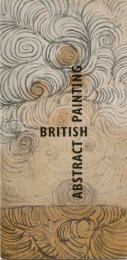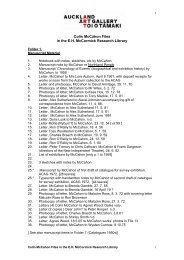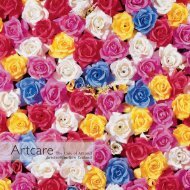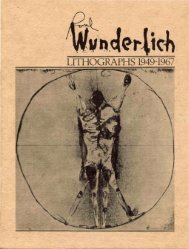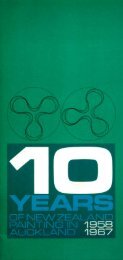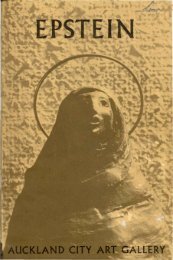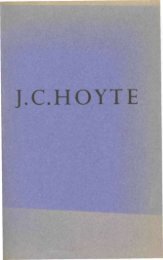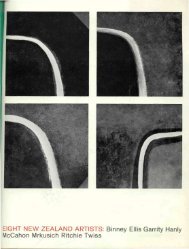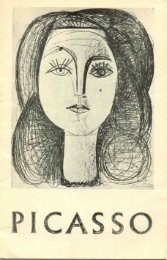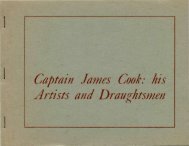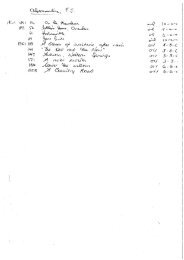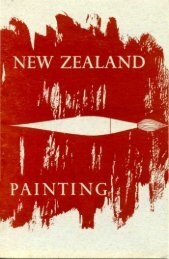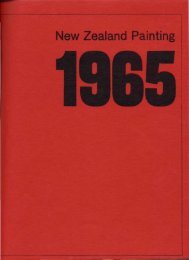Frances Hodgkins: Leitmotif - Auckland Art Gallery
Frances Hodgkins: Leitmotif - Auckland Art Gallery
Frances Hodgkins: Leitmotif - Auckland Art Gallery
You also want an ePaper? Increase the reach of your titles
YUMPU automatically turns print PDFs into web optimized ePapers that Google loves.
franceshodgkinsleitmotif
franceshodgkinsleitmotif
introductionIn the 1930s and 40s, <strong>Frances</strong> <strong>Hodgkins</strong> developed a highlypersonal response to what she termed ‘the Modern question’.The exhibition <strong>Frances</strong> <strong>Hodgkins</strong> – <strong>Leitmotif</strong> explores the mannerin which the artist’s drawing and watercolour techniquesbecome absorbed into her use of gouache and oil paint. Herevolving approach to painting is juxtaposed with the creativemanner in which she draws on recurring motifs. These appearnot only in <strong>Hodgkins</strong>’ still lifes and landscapes, but also in theunusual still life/landscape combinations that break down thetraditional division between space and form.Underlying the exhibition is the research carried out by<strong>Auckland</strong> <strong>Art</strong> <strong>Gallery</strong> conservators Ute Strehle and SarahHillary. Historically, conservation of <strong>Hodgkins</strong>’ work hasbeen hampered by a lack of information about her materialsand methods. In 2002, Hillary and Strehle obtained a grantfrom the Environment and Heritage Committee of theNew Zealand Lottery Grants Board Te Puna Tahua. Thisenabled them to investigate the materials and techniques usedby the artist. The project has taken 3 years to complete andduring this time Strehle and Hillary have examined many workson paper and paintings from a variety of periods in the artist’scareer, with particular focus on works from the <strong>Auckland</strong> <strong>Art</strong><strong>Gallery</strong> collection.Assisted by funding from Creative New Zealand, furtherresearch was undertaken at Tate Britain, London in 2004.Working closely with Dr Joyce Townsend, Hillary carried out atechnical examination of <strong>Hodgkins</strong>’ Wings over Water (c.1931-32)which uncovered the structural secrets of the painting. Theresults of that study will be published in the 2005 issue of theJournal of New Zealand <strong>Art</strong> History.
4frances hodgkinsleitmotifleitmotif: historically, a recurring short melodic phrase usedespecially in wagnerian music dramas, to suggest a character,thing etc; an often-repeated image or theme in a literary workfrances hodgkins in the village of corfe castle 1945 (detail from a photograph in the exhibition)felix h man collection, alexander turnbull library, 35mm-00337-c.Particular motifs appear repeatedly within the work of <strong>Frances</strong><strong>Hodgkins</strong> (1869–1947). Landscape, still life and portraiture arecentral to her oeuvre, but she treats each genre as if they are threadsin a tapestry, weaving and interweaving them so that still life floatsout into landscape, just as everyday objects representing her love ofpattern, colour and design become markers of self. In other hands,such a practice might have become repetitious, yet the clarity of hervision and her constant desire to push her painting technique innew directions ensured that each work embodies an untiringvivacity and individuality of expression.In the 1920s, <strong>Hodgkins</strong> moved away from the Impressionisttechnique that defined her earlier European works, and respondedin her own way to the movements within Modernism. From herearliest trips to France, she noted in her letters her attraction tothe Cubism of Picasso and Braque, as well as the simplified formsand brilliant colours of Matisse and Dufy, among others. The driveto find a new language of expression that spoke of the presentrather than the past was central to Modernism. The First WorldWar reinforced the desire for new beginnings, not just in subjectmatter but also in ways of working. British Modernists focused, inparticular, on exploring organic forms in relation to space, light andcolour. <strong>Art</strong>ists strove towards ways of expression based on personalresponse, allowing an individuality of style that would have beeninconceivable to earlier generations. <strong>Hodgkins</strong>’ place in BritishModernism was endorsed when she was elected to the Seven andFive Society in 1929. 1 Like other Modernists, <strong>Hodgkins</strong>’ work wasinformed less by history than by the present, interpreting the worldthrough a focus on form and structural relationships.
6leitmotiffig.1 red jug c.1931 oil on canvasauckland art gallery toi o tâmaki, purchased 1982The stark forms of the Mediterranean landscape and thevibrancy of life there were an ongoing source of subject matter for<strong>Hodgkins</strong>. She took particular pleasure in the carefully arrangeddisplays of fruit and vegetables in the markets. In her work she juxtaposestheir rounded forms and rich colours with the rough-hewnand often arid landscape, which proved such a contrast to the green,undulating hills and fields of England. In a letter to her sister IsabelField in 1901, she wrote:Then comes the green grocer with her two pretty daughters always beamingfrom behind a barricade of pumpkins, melons, pomegranates, figs and greenstuff. This is my favourite stall and I have made many studies of it. Then thereis a corner given up to pottery & earthenware of many colours & shapes. Theseare a great temptation to my purse… 2Her passion for such abundance was to stay with her throughouther long painting career. Still life objects, particularly jugs andjars or dishes of fruit, were often drawn individually as notes forform and colour, and then later combined in her still life and stilllife/landscape paintings.When she could, <strong>Hodgkins</strong> spent the winters in France andSpain. Her treatment of the still life idiom underwent subtlechanges during these sojourns in Europe. In Red Jug c.1931 [fig.1]the brilliant colour and decorative motif of the vessel is juxtaposedwith another jug whose more cubist form is flattened by a series oftonal layers. The jug contains lilies, a favourite flower that appearsmany times in her work. The vessels sit on a metal table close tothe picture plane, their forms animated by a twisting piece of paleblue cloth that rises up and drapes over what may be the residualoutline of the back of a chair. Throughout the thirties, fabric dartsand winds through her still lifes, starting as an animated cradle forfruits and vegetables in a manner reminiscent of Cézanne, but thendefying gravity to become a dynamic unifier of forms in a moresurrealistic space.
leitmotiffig.2 evening 1932-33 oil on canvasprivate collection, aucklandIn Red Jug a sense of depth is created by the inclusion of a baretree, again a favoured motif. <strong>Hodgkins</strong> had always preferred thesimplicity and structure of trees in winter and early spring. InEngland once she wrote:We had gone to bed under blue skys & woke up under low grey ones hangingover long reaches of red ploughed land broken by hedges & little clumpsof leafless trees looking like delicate etchings against the skyline. They are sobeautiful these leafless trees …I hate the idea of spring with its foolish greenleaves & sentimentality everyone here is babbling about it, the first primroseetc…. The beech trees are brown with bud & in a week or two the wretchedleaves will be out. They are to me infinitely more beautiful in their present stateand I must hurry up & get some sketches before they turn. 3A number of paintings from the early thirties are differentiated bya radical treatment of the sky which is comprised of broad bandsof colour, giving a prismatic effect of atmosphere. While it is oftendifficult to locate <strong>Hodgkins</strong>’ paintings, which she invariably signedbut hardly ever dated, works that demonstrate particular painterlyeffects generally indicate a particular period. Green Urn c.1931 bearsthe same striated sky as Red Jug, although the precarious positionof a vase beside melons on the lip of a large urn is a compositionpossibly influenced by an earlier work by Picasso. 4 In these paintings,still life objects – vases, jars, urns, jugs – are judiciously placedto create diverse readings of their relationship to the landscapebeyond. In Red Jug and Green Urn they dominate the foreground sothat we have to look through them to the countryside, whereas inanother Ibizan painting, Evening 1932-33 [fig.2], the table is like analtar and we look over the vases to a broader landscape beyond. Therosy tones of the land seem to cast light back over the table, whilean isolated white house stands in the background, framed in themiddle ground by grape leaves on a residual loggia. <strong>Hodgkins</strong> oncedescribed working on an indoor still life, ‘I bought 2 white lilies togive it the white note – it just gives it that ‘kick’ as a composition. The
10leitmotiffig.3 phoenician pottery and gourds c.1933 watercolourauckland art gallery toi tâmakipurchased with funds from the winstone bequest, 1954fig.4 ibiza, c.1933 oil on canvasauckland art gallery toi o tâmaki, purchased 1982black pot was introduced at a later stage – to the picture’s enhancement…’5 A considerable number of paintings from this decade usea white house or barn as an anchoring device in the landscape.<strong>Hodgkins</strong> described how differently the light appeared in Ibizain a letter to painter and textile designer, Karl Hagedorn:…in this clear ivory light every common object looks important & significant …things appear in stark simplicity minus all detail – nothing corked up (bouchée)or hidden as in grey, or brown light of the north. Of course, later on, this intensesun light will convert colour & form into absolute negation but at the momentthere is complete livlieness [sic]. The pale coloured flat roofed houses withoutwindows give a blind restful feeling, of immense space. 6Certain of her paintings took on a surrealist aspect. In Phoenicianpottery and gourds c.1933 [fig.3] objects float in their own individualspace, hovering above the strong brown diagonal strokes ofwatercolour which evoke the rich ploughed Mediterranean earth.On the right, a jug and gourd stay anchored to the ground, a softwash suggesting a ghostly cloth behind and beneath them. A singleflower, surrounded but not attached to vestigial twigs, seems tohave emanated from some other scene, while a lone flash of blueimplies the distant hills more clearly defined in views of the harbourat Ibiza.<strong>Hodgkins</strong> was particularly drawn to the Mediterranean’ssimplified block-like architecture [fig.4]. Her appreciation of theircubic shapes was later translated into the domestic architecturalforms in the English landscape, although she found it much harderto interpret the verdant growth so different from the spare landscapeof the South. Once, when staying in Suffolk, she wrote, ‘Mybrain reels trying to reduce this exuberant Nature to pictorial form– it is so gross green & lush… I shall have to make for France if Iam to get any work. Here I feel lost in a deadening sea of growth…’ 7It was only after the Spanish Civil War made it difficult to returnto the Mediterranean that <strong>Hodgkins</strong> finally came to terms with the
12leitmotiffig.6 elsie barling 1931 pencilauckland art gallery toi o tâmakigift of gerald selby, from the estateof dorothy selby, 1954fig.5 pumpkins and pimenti c.1935-36oil on canvasthe fletcher trust collection,aucklandsoft, delicate forms and light patterns of the English countryside,ultimately declaring that there was nowhere else quite like it.Friends and critics were fascinated by her use of colour.Myfanwy Evans, who later wrote the Penguin book on Hodgkin’swork, described it as having ‘the same quality as some fine poetry… She has no formula, but the colour of each picture is as indicativeof a mood as a blushing and sensitive skin’. 8 Pumpkins and Pimentic.1935-36 [fig.5] was one of a group of paintings that came from awinter spent in Tossa de Mar in Catalonia between 1935 and 1936.In these works <strong>Hodgkins</strong>’ palette changed radically, while her bird’seye view of the landscape heralded the more abstract works of the1940s. Eric Newton wrote:To call her colour ‘delicious’ is merely to praise it without giving an inkling asto its quality; but, for want of an adequate vocabulary, one must leave it atthat. Titian’s colour glows, but it lacks acidity; Matthew Smith’s is luscious andexuberant, but it is simple like tropical sunshine. <strong>Frances</strong> <strong>Hodgkins</strong> needs afiner adjustment. Hers is a twilight colour. It is queer and surprising. Moreover,it continues to be surprising. Looking at her best gouaches, the eye, long afterthe first impact, goes on receiving little subsidiary shocks of delight. 9He returned to the theme on a later occasion:She can… make certain colours ‘sing’ as they have never done before – inparticular a certain milky purplish-pink, a most unpromising colour: she canmake greys and browns look positively rapturous: she can juggle with colourorchestrally. 10Not all her work was of still life and landscape, as she also produceda considerable number of portraits throughout much of her career.Her drawing of Elsie Barling 1931 [fig.6] was done at Wilmingtonin Sussex. Barling recalled coming down a little winding staircaseand <strong>Hodgkins</strong> asked her to stay still for a moment while she drewher. The drawing, which reflects the artist’s eye for pattern anddesign, was given to their mutual friend Dorothy Selby, who was
14leitmotiffig.7 kimmeridge foreshore c.1938 oil on canvasvictoria university of wellington collectionalso staying there. <strong>Hodgkins</strong> was particularly adept at suggestingintimacy in both the double format, a composition to which sheseemed drawn, and in family groups which often comprised amother and her children. Furniture or the patterned fabric ofgarments was often used to link the figures together in a rhythmicalmanner. 11Rather than creating a dynamic surface in a three-dimensionalspace on which objects were placed, in later still lifes fabric becamea kind of inner frame, rising vertically on the surface of the canvas.This is particularly evident in her wry self-portrait still lifes, wherean arrangement of brightly patterned scarves intertwine, a jumblednest for items from her wardrobe, such as a shoe, handbag, belt ormirror. 12 Dating these self-portraits is particularly difficult. Theywere given originally to close friends such as Geoffrey Gorer andCedric Morris, and so may never have been intended for publicdisplay. In a letter to her friend the Neo-Romantic painter, JohnPiper, in the latter part of 1941 <strong>Hodgkins</strong> described how she perceivedthe relationship between herself and her work; ‘Myself, Iwould say that I, my medium, and my subject act & react to producenew & vital creations &, if possible, achieve a perfect balance‘.While she felt comfortable translating the figures of others, <strong>Hodgkins</strong>pre-empted Postmodernism in recognizing the impossibility ofcapturing the self in a single image.Once war was declared in 1939, neither the bold clarity of theMediterranean with its brilliant light and seductive forms, nor thelush English countryside were easily accessible. By necessity <strong>Hodgkins</strong>was forced to paint the surroundings close to hand, which for themost part were defined by the area known as the Isle of Purbeck,with Corfe Castle, her home for much of the war, near its centre.Kimmeridge Foreshore [fig.7], begun in 1938 but not exhibited until1940, reflects her ongoing practice of painting from memory, whereher concentration on form and composition would not be marredby the profusion of detail in the landscape. During this period
16leitmotiffig.8 purbeck farm 1942 gouacheauckland art gallery toi o tâmaki, purchased 1955she made a number of paintings which depicted ghostly farmyardmachinery, their forms looming out of spaces only faintly definedby the outline of barns, hayricks and harvesters. Whereas her earlierstill lifes often floated into the landscape, now the objects themselvesare fused with atmospheric effects that seem to wrap around them.Farmyard activities had been the focus of British artists in the early1920s as symbols of timeless productivity in harmony with the land[fig.8]. By contrast, the Neo-Romantics, with whom <strong>Hodgkins</strong> wasloosely grouped in this latter period, saw such machinery, especiallywhen decayed or inactive within a rural setting, as emblematic of theeffects of war on society. Some of <strong>Hodgkins</strong>’ most powerful worksduring the war refer to the blackout – abstracted nocturnes –darkness filled with traces of colour and the memory of light.Invocations of favourite motifs continued to take the viewer bysurprise. A review of her exhibition in 1937 noted:<strong>Frances</strong> <strong>Hodgkins</strong> is a genuinely individual painter who has slowly evolvedher own idiom to express her own novel vision… [She] looks at the objects shedepicts – flowers and fruit, landscape and animals, implements of farm andhousehold – as though she were seeing them for the first time, without meaningor association; nothing for her is too common or mean, or too rare and exotic. 13<strong>Hodgkins</strong>’ career was marked throughout by her determinationto succeed as a painter. She confronted the wide-ranging developmentsin Modernism, experimenting with painting techniquesto create her own personal and innovative style of working.Her ability to interweave favoured motifs into her paintings,while never ceasing to explore their relationship to space and form,ultimately led <strong>Frances</strong> <strong>Hodgkins</strong> to what <strong>Art</strong>hur Howell recognisedas an astounding abstract control of all she put on her canvas.Mary KislerMackelvie Curator, International <strong>Art</strong><strong>Auckland</strong> <strong>Art</strong> <strong>Gallery</strong> Toi o Tamaki -
18notesfrances hodgkinsat her best‘Try to be a little freer & more spontaneous…’ wrote <strong>Frances</strong> <strong>Hodgkins</strong>to her pupil, Hannah Ritchie in 1917. ‘Don’t reproduce – Get thecharacter & essential spirit of the place in the simplest manner – ’. 11. The Seven and Five Society was formed in 1919 andevolved into the leading Modernist art group in Britain.Other members included Henry Moore, Paul Nash,Cedric Morris, Ivon Hitchens and Ben and WinifredNicholson. However, in 1924 after it was renamed theSeven and Five Abstract Group, <strong>Frances</strong> <strong>Hodgkins</strong>resigned. Contracts to exhibit, first at St George’s<strong>Gallery</strong> from 1929, and then at the Lefevre and LeicesterGalleries were turning points in <strong>Hodgkins</strong>’ career.2. Linda Gill, ed., Letters of <strong>Frances</strong> <strong>Hodgkins</strong>, <strong>Auckland</strong>,1993, p.105, written from Hotel du Forum, Arles surRhone.3. Gill p.119, letter to Isabel Field , 7 March 1902, Penzance.4. Elizabeth Eastmond, in Iain Buchanan, Michael Dunn,Elizabeth Eastmond, <strong>Frances</strong> <strong>Hodgkins</strong>: Paintings andDrawings, <strong>Auckland</strong>, 1994, p.138.5. Gill p.414, letter to Lucy Wertheim, 23 April 1929,London.6. Gill p.456, letter to Karl Hagedorn, 29 January 1933, Ibiza.7. Gill p.432, letter to Lucy Wertheim, c.9 August 1930,Bergholt, Suffolk.8. Myfanwy Evans, ‘Round the <strong>Art</strong> Exhibitions’, Listener,18 April 1940, p.778.9. Eric Newton, review of <strong>Frances</strong> <strong>Hodgkins</strong> exhibitionLeicester Galleries Oct 1941, in Listener, 2 October 1941,p.473.10. <strong>Frances</strong> <strong>Hodgkins</strong> Retrospective Exhibition, Lefevre<strong>Gallery</strong>, Nov 1946, foreword by Eric Newton, p.3,quoted in Gill, p.9.11. <strong>Hodgkins</strong> worked briefly as a fabric designer inManchester in 1927.12. Although the colour is quite different, the itemsincluded in both <strong>Auckland</strong> <strong>Art</strong> <strong>Gallery</strong>’s Self PortraitStill Life and that owned by Te Papa in Wellington aresimilar in many ways.13. Review by Geoffrey Gorer in Listener, 17 November 37.14. <strong>Art</strong>hur R Howell, Four Vital Years, London, c.1951, p.24.fig.9 berries and laurel c.1930 oil on canvasauckland art gallery toi o tâmaki, purchased with fundsfrom the william james jobson trust, 1982Although <strong>Frances</strong> <strong>Hodgkins</strong>’ technique variedconsiderably during the course of her longcareer, spontaneity and simplicity remainedessential components throughout. Her lively andcalligraphic brushwork, modification of form andcolour, all worked together to produce somethingunique. <strong>Hodgkins</strong>’ high standards meant she wasfrequently dissatisfied with the results of herwork, causing her to carry out major changes orsometimes to reject the work completely. She didnot slavishly follow traditional painting methodsbut experimented to gain the freshness that shedesired in all of the media she used. Furthermore,the financial difficulties that plagued <strong>Hodgkins</strong>all her adult life had an effect on her choice ofmaterials, another re-occurring influence on herpainting practice.<strong>Hodgkins</strong>’ father, William Matthew <strong>Hodgkins</strong>,(1833-98) was a gifted amateur artist in NewZealand and taught both of his daughters howto paint with watercolour. In 1893, visiting Italianpainter Girolamo Pieri Nerli gave <strong>Frances</strong> furtherinstruction, two years before she enrolled inthe Dunedin School of <strong>Art</strong> to obtain her SouthKensington examinations. The Dunedin Schoolprovided a traditional training in the use ofwatercolour, illustrated in the ‘vignette’ styleof her portraits of Maori women and children.The background remains unpainted and thefaces are modelled with thin washes utilizing the
24frances hodgkins at her bestdisparate hues facilitated by the use of powdercolours. 14 Mixtures included viridian green androse madder for skies in 1917, and a combinationof viridian, organic red and yellow, carbonblack and lead white for musty pink in Berries andLaurel 1930. Other pigments used by the artistin both water-based and oil-based paints wereearth colours: yellow ochre and Mars red; organics:yellow, red and rose madder; and inorganicpigments: artificial ultramarine, Prussian blue,chrome yellow, and lithopone (zinc sulphide andbarium sulphate). At least until the early 1920s,<strong>Hodgkins</strong> not only used lead white for highlightsin her watercolours and gouaches, but shealso mixed it with other pigments. A surprisingnumber of organic colours mixed with lead whitewere identified in the oil paintings from the1930s, particularly in Wings over Water. This mayindicate a less expensive brand of paint was usedas organic pigments tended to be cheaper, despitemany artists avoiding them because of questionsabout their permanency.<strong>Hodgkins</strong> was considered a leading BritishModernist by the 1940s, even though for most ofher life she had found it impossible to rely on herpainting alone and was forced to supplement herincome by teaching. Her poor financial situationand wartime shortages inevitably affected thechoice and the availability of materials. Friendsoften helped her out, not only because of the costbut also because of her preference for working inrural locations without well-stocked art suppliers.For this reason, the artist used whatever paperswere available for drawing and painting, althoughshe did obtain high quality materials from timeto time. The watercolour Ibiza – Study for oil 1935for example, is painted on a 100% fine cotton ragpaper produced by J Green & Son, who ran thefig.21 raking light highlights the changes tored jug (see also fig.1).fig.22 bradford-on-tone, geoffrey gorer’scottage 1940 gouache, auckland art gallerytoi o tâmaki, purchased 1970fig.23 photomicrograph of dry pigment mixedinto the paint bradford-on-tone, geoffreygorer’s cottagefig.24 watermark from the company fj head & coin transmitted light from ibiza – study for oil(watercolour)fig.25 detail of the loose weave canvas used forstill life with landscapeHayle Mill in Kent [fig.24], whereas the watercolourBoys heads, Treboul 1927 is painted on a poorquality machine-made paper. When she has usedcommercially prepared canvases they are oftenof a lower grade, being loose-weave with singlegrounds and lightweight stretchers [fig.25].<strong>Hodgkins</strong> certainly re-used papers and probablycanvas supports as well. There are faint images ofworks on the reverse of watercolours, Eggs & Fernsc.1931 and Phoenician Pottery & Gourds c.1933[fig.3] which have been rejected and wiped out,whereas in an earlier oil, The Edwardians c.1919,the artist has reused the canvas and stretcher ofanother work and painted over the top. 15The re-occurring practices identified in the workof <strong>Frances</strong> <strong>Hodgkins</strong> can be seen to display aleit-technique, where the use of watercolour isfundamental and has an influence throughouther career. Early oils and tempera paintings havea direct connection in their transparent colours,washes and calligraphic lines. Later the rapid andfluid brushstrokes of her oils and gouaches continuethe watercolour legacy. During <strong>Hodgkins</strong>’time in Paris, a change in her watercolour techniquefrom traditional washes to long brushworksaw a shift in focus from naturalistic representationto an interest in the paint materials and thesurface itself. This was then further developedin her use of opaque, textured oil and gouacheand in the use of colour, from brilliant transparencyto milky hues. Despite <strong>Hodgkins</strong>’ evocation`…that a good picture will out like MURDER…’the work seems effortless and retains a wonderfullyrical quality so desired by the artist. 16Sarah Hillary and Ute StrehleConservators<strong>Auckland</strong> <strong>Art</strong> <strong>Gallery</strong> Toi o Tamaki -
26notes1. Gill p. 326. Letter to Hannah Ritchie, August 1917,St Ives, Cornwall.2. Maxwell Edith Riddle, Women and Modernity: Thecase of <strong>Frances</strong> <strong>Hodgkins</strong>, an investigation of her useand abandonment of the image of women, unpublishedMA thesis, Victoria University of Wellington,1997, p. 97.3. The tempera medium is primarily animal gluemixed with some oil (walnut, or poppy and linseedoil), and may have a little egg or casein added.Protein analysis was carried out by Brian W Singer,Northumbria University, August 2005; and the oilswere identified at Tate Britain in July 2004 (JuliaJonsson, Bronwyn Ormbsy, Tom Learner, Analysisof <strong>Frances</strong> <strong>Hodgkins</strong>’ Paints).4. Riddle pp. 128-9, Evening Post, January 1907, quotingthe Pall Mall Gazette. Cedric Morris (1889-1982), afellow painter who <strong>Hodgkins</strong> befriended and stayedwith at his house in Newlyn in 1919, also had a loveof paint texture and this was particularly overt in hiswork from 1920-25.5. English artists Barbara Hepworth (1903-1975) andHenry Moore (1898-1986) also used this technique.6. Gill p. 544, letter to Duncan Macdonald, 31 January1944, Corfe Castle, Dorset.7. Gill pp. 471-2, letter to Duncan Macdonald, c.12November 1936, Corfe Castle, Dorset.8. Archival mounting and framing, the display in alocation with a stable temperature and humidityaway from high light levels, can considerably aid thepainting’s longevity.9. Gill p.459, letter to Dorothy Selby, 3 September1933, London. Coverine was a white householdpaint and there is evidence to suggest that it wasused by Christopher Wood, Ben Nicholson andothers in the 1920s. It was applied as an undercoatas well as to paint over previous paintings so thatthe canvas could be re-used. Harriet Standeven,personal communication, 13 June 2005.10. Douglas Glass, from the complete transcript oftapes by June Opie, Hocken Library, Otago University,CIP IRN 74/63.11. Gill p.464, letter to AJ McNeill Reid, 11 January1935, Corfe Castle, Dorset.12. Gill p. 326, letter to Hannah Ritchie, August 1917,St Ives, Cornwall.13. Gill p. 9.14. Technical examination at <strong>Auckland</strong> <strong>Art</strong> <strong>Gallery</strong> andTate Britain.15. Apart from the four labels for The Edwardians onthe reverse, there are two others for a work titledNightpiece. A work of that name was exhibited in1919 at the Society of Women <strong>Art</strong>ists, a year beforeThe Edwardians was first shown (brought to ourattention by Iain Buchanan). Although the canvasedges are very uneven in length, the regular spacingof the tacks would appear to indicate that the canvaswas commercially prepared and has not beenremoved. There was certainly time to re-paint, andthe numerous layers with unrelated impasto wouldappear to confirm this theory.16. Gill p. 563, letter to David Brynley, 2 November1945, Corfe Castle, Dorset.Works referred to in the text but not illustrated:<strong>Auckland</strong> <strong>Art</strong> <strong>Gallery</strong> Toi o Tamaki - collection:Boys heads, Treboul 1927, watercolourEggs & Ferns c.1931, watercolourIbiza – Study for oil 1935, watercolourRefugee Children c.1916, oil and temperaSpanish Shrine c.1933-34, oil on canvasThe Edwardians, c.1919, oil on canvasTate Britain:Loveday and Ann 1916, oil on canvasWings over Water c.1931-32, oil on canvasPrivate Collections:Hill Landscape 1935-36, gouacheLancashire Children c.1927, oil on canvasGreen Urn c.1931, oil on canvasfrances hodgkins at her studio in the village of corfe castle, dorset, england, 1945 (detail from a photograph in the exhibition)felix h man collection, alexander turnbull library, f-332-35mm-d.
acknowledgementsAs well as the many generous private collectors whohave lent to this exhibition, <strong>Auckland</strong> <strong>Art</strong> <strong>Gallery</strong> Toio Tamaki wishes to thank the following:New Zealand Lottery Grants Board Te Puna Tahua;Creative New Zealand; Tate Britain; Tate ConservationDepartment; <strong>Auckland</strong> Radiology; The Research Centrefor -Surface and Materials Science and ChemistryDepartment of the University of <strong>Auckland</strong>; DunedinPublic <strong>Art</strong> <strong>Gallery</strong>; Museum of New Zealand Te PapaTongarewa ; Christchurch <strong>Art</strong> <strong>Gallery</strong> Te Puna oWaiwhetu; Parliamentary Services, Wellington; VictoriaUniversity of Wellington; Hocken Library, University ofOtago; Fletcher Trust; Rutherford Collection; RavenscarTrust; Ferner <strong>Gallery</strong>; John Leech <strong>Gallery</strong>.Published on the occasion of the exhibition<strong>Frances</strong> <strong>Hodgkins</strong>: <strong>Leitmotif</strong> at <strong>Auckland</strong> <strong>Art</strong> <strong>Gallery</strong> Toi o Tamaki12 November 2005 – 2 April 2006Exhibition Curators: Mary Kisler, Sarah Hillary, Ute StrehleExhibition Conservators: Sarah Hillary, Ute StrehleResearch Librarians: Catherine Hammond, Caroline McBridePhotography: John McIver, Sarah Hillary, Ute StrehlePublication Design: www.inhousedesign.co.nz-ISBN 0-86463-266-5This book is copyright. Except for reasonable purposes of fairreview, no part may be stored or transmitted in any form or by anymeans, electronic or mechanical, including recording or storage inany information retrieval systems, without permission in writingfrom the publishers. No reproductions may be made, whether byphotocopying or by any other means, unless a licence has beenobtained from the publishers or their agent.Copyright © 2005cover: ibiza, c.1933 (detail), oil on canvasauckland art gallery toi o tâmaki, purchased 1982EXHIBITION MAJOR SPONSOR



